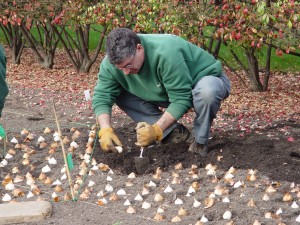Tip of the Week: Planting Bulbs
Posted in Gardening Tips on October 19 2009, by Sonia Uyterhoeven
 |
Sonia Uyterhoeven is Gardener for Public Education. Join her each weekend for home gardening demonstrations on a variety of topics in the Home Gardening Center. |
 Over the past year the horticulture department staff has had some wonderful master classes on planting bulbs through the visits of Seasonal Walk co-designer Jacqueline van der Kloet and a slew of other Dutch visitors. They arrived with their heart-shaped trowels (plantschopje) that were indicative not only of their practicality in planting but their love for anything bulbous.
Over the past year the horticulture department staff has had some wonderful master classes on planting bulbs through the visits of Seasonal Walk co-designer Jacqueline van der Kloet and a slew of other Dutch visitors. They arrived with their heart-shaped trowels (plantschopje) that were indicative not only of their practicality in planting but their love for anything bulbous.
The heart-shaped trowel has a very sharp point that is ideal for stabbing the soil and pulling it back to drop in a bulb. Bulb growers these days have diversified from the traditional trowel taking advantage of an array of shapes and sizes. Some are slim and narrow for those bulbs that need to go deep into the bowels of the earth, while others are wide with sharp tapered points that act like mini-spades. See Brent and Becky’s Bulbs and our Shop in the Garden for some good selections.
Regardless of what is in your hand, it is important to remember when planting a bulb to hold the trowel as you would a dagger, with the front facing your body. Stab the soil, pull the trowel toward you, and simply drop the bulb in. It’s actually not so simple when the bulbs number in the hundreds or thousands. But this method will help you get a good rhythm going to carry you through.
I generally stand when planting, hinge at my hips, slightly bend my knees, and get to work. If you prefer crouching or kneeling, be aware of the ground you are working on. At the Garden, we stand on planting boards while we work so as not to compact the soil; the boards even out the pressure. The ideal, of course, is to keep your feet out of the border by leaning over from the perimeter, but this is not always possible.
While planting method is important, what captured the imagination of visitors last spring was the intelligent design on Seasonal Walk. It was revealed not only in the interesting mixtures of bulbs, but also in the style of planting.
Seasonal Walk—the canvas for Jacqueline van der Kloet’s bulb planting—was broken down into a number of different components. Tulips (Tulipa) were planted in medium-size drifts that were interspersed throughout the border, weaving from front to back. Clumps of tall daffodils (Narcissus) punctuated the border, adding structure to the spring display. Flowing in among these islands of color was a dense trail of smaller bulbs.
The bulbs formed a cohesive design that wove its way, uninterrupted, through the entire border. The minor bulbs such as Iris reticulata ‘Harmony’, Chionodoxa forbesii ‘Pink Giant’, Muscari armeniacum ‘Valerie Finnes’, and Scilla siberica ‘Alba’ were mixed in equal proportions into a bucket and then tossed in a natural manner among large drifts of perennials.
This casual way of distributing bulbs was deliberate—it created a natural effect where the small minor bulbs were popping up through the perennials and filling in the empty spaces. Bulbs were planted in quantity to form what van der Kloet refers to as a “tapestry of spring color.” The minor bulbs were spaced from 1 to 3 inches apart and planted 2 to 3 inches deep.
Minor bulbs are an excellent choice to plant between perennial drifts. By the time the early bulbs have flowered and their foliage is finished, the perennials are starting to grow and take over the area. Later in the season the bulbs are protected by the perennials and will not become the victim of an unwieldy spade that is eagerly filling in bare spots with summer annuals. The perennials mark the space for the bulbs.
The drifts of tulips and daffodils interspersed throughout the border also elegantly celebrate the emergence of the delicate foliage of perennials in early spring. The larger bulbs formed islands that were surrounded by a sea of perennials. The feathery foliage of Astilbe chinensis ‘Vision in Pink’ and Actaea simplex (Atropurpurea Group) ‘Brunette’ created a beautiful foil for the pastel blends of daffodils and tulips.
The color palette that Jacqueline van der Kloet chose was subtle. It integrated nicely into the naturalistic design of the perennials and picked up many different hues of spring from the flowering crabapples (Malus) to the varying tones in the perennial foliage.
The tulips were an assortment ranging from dark to pale pastel colors in a graduated fashion that encouraged the blending of the various colors. The heights also varied slightly, giving it a flowing and natural feel. These larger bulbs were dug deeper into the ground: 5 to 6 inches is the norm and spaced 4 to 6 inches apart.
Just a small warning to the homeowner: A friend of mine integrated a mix of two different tulips into his border this spring and forgot to pay attention to heights. The end result was that one variety dwarfed the other.
Remember that nature doesn’t work in choppy motions. Emulating the natural rhythms, subtle color harmonies, and graduated heights that we find in nature is an important requirement to any naturalistic design—whether you are working with bulbs or perennials.

